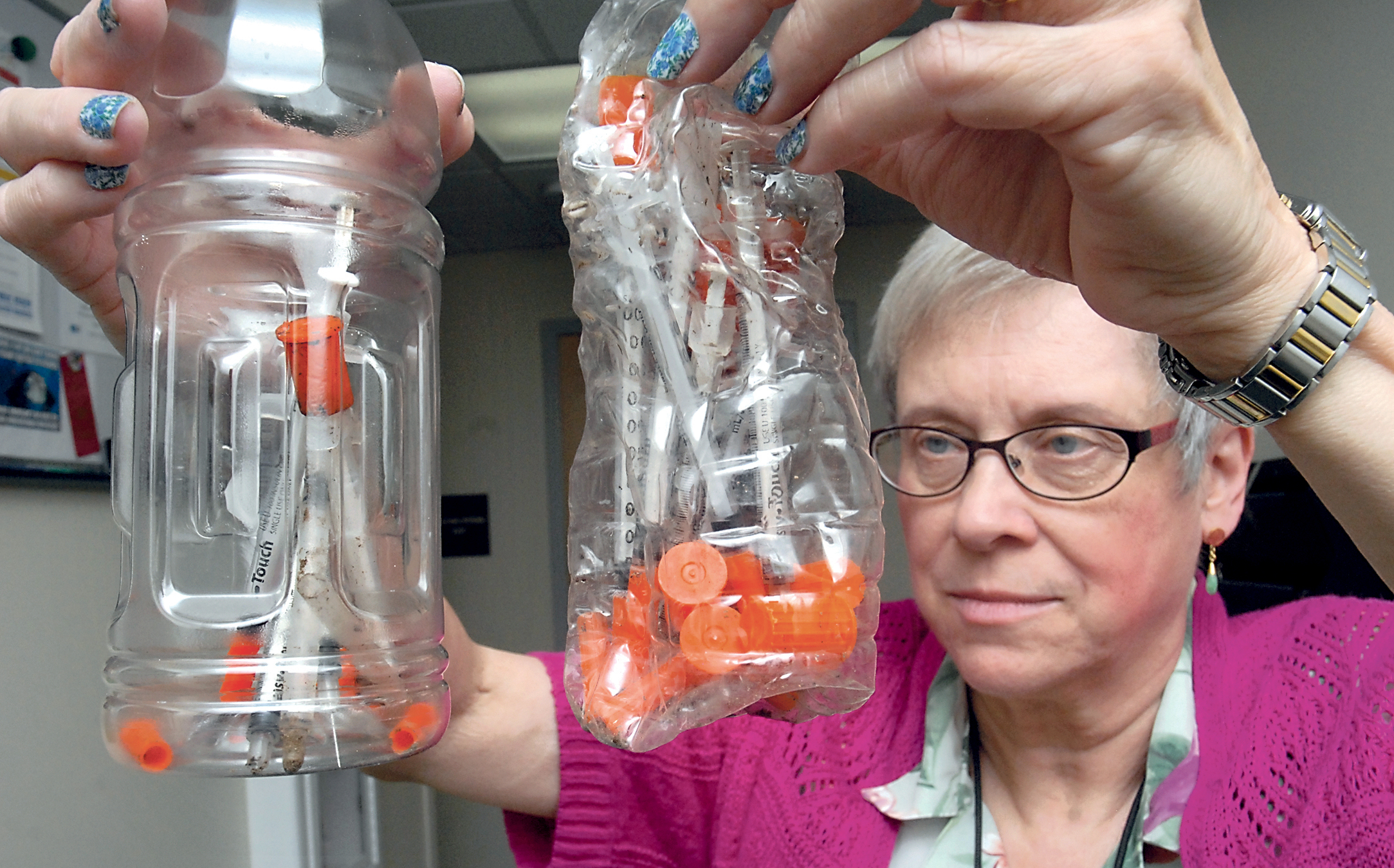PORT ANGELES — When it comes to heroin, Iva Burks and Christina Hurst are on pins and needles.
The pins Hurst pushes into a map of Clallam County show where addicts discard dirty syringes.
In the three months she’s been tracking them, most have turned up along the Port Angeles waterfront; in Jessie Webster Park, Third and Eunice streets; along Peabody Creek; and in Francis Street Park above the Waterfront Trail.
Near Sequim, syringes have turned up mostly in the Sol Mar area and at Robin Hill Farm.
Burks, director of the county Health and Human Services Department, and Hurst, manager of public health programs, are tracking where citizens find syringes and informing them how to safely dispose of them.
Some heroin addicts drop them on the ground, testimony to the soaring use of opiate drugs in Clallam County, whose death rate from prescription opioid and heroin overdose was 29 per 100,000 in 2013, nearly twice the state’s overdose death rate of 14.8 per 100,000, health officials have said.
Hurst has been logging such locations on a map in her office at 111 E. Third St., Suite 1-A, since July.
She’s about to switch from pushpins to dressmaker’s pins because the map is getting crowded and the pins with smaller heads more accurately mark where needles are found.
They total in the hundreds, Hurst said. Most of the needles supplied to drug users in the Syringe Service program are returned for safe disposal and traded in for new ones, Hurst and Burks said.
Of the 275,000 syringes supplied, 274,946 were returned to the county health clinic.
Hurst will travel to Forks next week to set up a syringe-reporting and retrieving network, “and I’m hoping to get something set up in Sequim,” she said.
The citizen efforts will be on the agenda of a meeting of Health and Human Services personnel Dec. 1 at Olympic Medical Center in Port Angeles to review the county’s Community Health Improvement Plan.
“We want at the end of that meeting to have a plan of things that actually can be accomplished to make an impact on the opioid problem,” Burks said.
Steps in the direction already include a case manager who counsels opioid users about to be released from the Clallam County jail to inform them of treatment opportunities and to offer the same information to users of the county’s Syringe Services program.
They also are working with the Port Angeles Citizen Action Network (PA CAN), the youth group Hope After Heroin, the Feiro Marine Life Center, the city of Port Angeles and the North Olympic Salmon Coalition to clean up the downtown district and nearby areas where syringes often are found.
A “Get the Point” brochure is available at the public health clinic, 111 E. Third St., where people also can bring found needles if they wish.
The syringes must be enclosed in plastic beverage bottles, not placed in plastic shopping bags or paper cups.
“Our staff needs to be protected as well,” Burks said Friday.
Public health personnel cannot retrieve syringes themselves but urge citizens to report where they find them by calling 360-417-2274.
Upcoming cleanups
More immediately, the county and its volunteer allies have scheduled more cleanups around Port Angeles. The first was held July 25 at Jessie Webster Park, Francis Street Park, Lincoln Park and Erickson Playfield.
Upcoming cleanups include:
■ 3:30 p.m. Friday at the Laurel Street Stairs and alleys behind downtown Port Angeles businesses. It will be led by Hope After Heroin members; all volunteers will be welcome.
■ 12:30 p.m. Oct. 29 along Benson Road south of U.S. Highway 101 west of Port Angeles and the nearby Welcome Inn Trailer and RV Park, 1215 U.S. Highway 101.
■ 11 a.m. Oct. 30 at Lincoln Park, 1900 W. Lauridsen Blvd., Port Angeles.
■ 9 a.m. Nov. 14 along Peabody Creek.
Trash bags, garbage grabbers, gloves and hand sanitizer will be provided for all the events by the city of Port Angeles, which also will accept the collected refuse at its transfer station at 3501 W. 18th St., Burks said.
The events will include general cleanups. The first Peabody Creek event netted 460 pounds of candy wrappers, food bags and an occasional pieces of clothing, Hurst said.
But they’ll also serve as data collections to determine where and how many people are using heroin.
“The big thing we’ve discovered is that all of us have been seeing little pieces of this,” Hurst said.
“Now we’re seeing how we can work together and seek long-term solutions.
Hurst and Burks lauded Tina Sperry, coordinator of Hope After Heroin, and Angie Gooding of PA CAN for their role in involving people.
Hurst’s message to others:
“Don’t waste your time complaining that the needles are there. Put them into a bottle and get them disposed of.
“We realize there are problems in the community. We want to be part of the solutions.”
_______
Reporter James Casey can be reached at 360-452-2345, ext. 5074, or at jcasey@peninsuladailynews.com.

